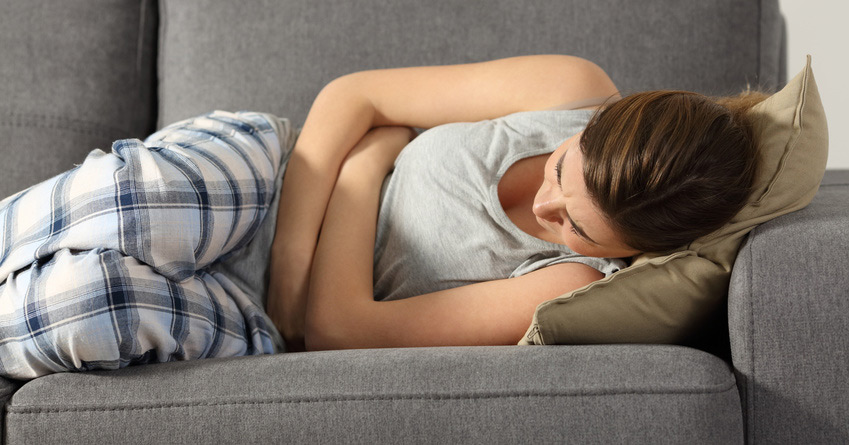
Photo – © Antonioguillem – fotolia.com
The word “dysmenorrhea” often strikes fear (or, at the very least, incites a flinch) in the hearts of women all over the world. In lay-person’s terms, dysmenorrhea is menstrual cramps, which are symptoms that accompany a woman’s monthly period or menstruation. Women can experience throbbing or cramping pain usually in the lower abdomen, but may feel pain in the thighs and lower back. [1]
However, dysmenorrhea is classified into two types: primary and secondary dysmenorrhea. The common type of menstrual cramps is referred to as primary dysmenorrhea which is cramping not caused by underlying diseases or conditions. Women may experience varying degrees of pain that may start before or during the menstruation which may last for a few hours or up to a few days. On the other hand, secondary dysmenorrhea is typically caused by underlying health problems such as infection, endometriosis, or uterine fibroids. Pain in conditions of secondary dysmenorrhea starts before bleeding and last longer than what is normal. [1]
Because of pain being constantly experienced by women on their periods, their quality of life and productivity is normally affected. Various studies have shown that women who experience dysmenorrhea may find it difficult or even impossible to go about their regular daily tasks. This in turn may negatively the performance of women either in school or work, and can even affect their relationships.
If you think it is quite easy to pop a few pills to get the pain over with, you are wrong. There are plenty of side-effects that taking over-the-counter pain medication has – among them damage to the stomach and the development of gastric ulcers. With this in mind, listed below are 7 natural home remedies to help manage the pain from menstrual cramps.
1. A Warm Bath
Since menstrual cramps are caused by the contractions of the uterus as it expels blood, a warm bath can help ease the pain by facilitating the relaxation of the uterine muscles. Application of heat can also encourage proper circulation to the pelvic area by opening up the blood vessels in the uterus, which helps in bring back oxygen to these muscles (since constant muscle contraction can lead to oxygen depletion and acetic acid formation, the latter causing pain, typically seen in people after they exercise). Kober, et. al. in 2003 concluded that heat application called “active warming” was an effective way to manage pain in other conditions where patients are not permitted to take any pain-controlling medication. This method was observed not to have any side effects at all! [2]
2. Exercise
Exercising regularly helps to keep you healthy and reduces the occurrence of dysmenorrhea. Some studies have shown that exercising during your period helps decrease the pain. A publication in the American Family Physician Journal by Osayande and Mehulic from the University of Texas Southwestern Medical Center cited exercise as a protective factor in cases of dysmenorrhea. This may be attributed to the release of chemicals in the body called endorphins. These chemicals help relieve the pain by blocking receptors of other chemicals in the body that cause pain. Similarly, a study on isometric exercise by Azima, et. al. in 2015 reports that exercise was able to reduce symptoms of dysmenorrhea, although with less effective results than massage therapy. [3][4]
3. Eat Bananas
While there are currently no studies that directly link banana intake to reduced pain, there are plenty of studies focusing on an electrolyte that can be found abundantly in bananas –potassium. Potassium plays a big role in muscle contractility; low potassium levels can lead to the development or worsening of cramps in the muscle. Similarly, the potassium receptors in our body also play a role in pain management, wherein enhancing them decreases the body’s excitability of the body’s pain receptors. That said, including banana in your diet can boost your potassium levels which in turn can help with managing pain caused by menstrual cramps. [5]
4. Drink Ginger Tea
Ginger has been used in herbal medicine for thousands of years, able to manage various gastrointestinal problems – which is why ginger ale or tea is quite popular today in managing stomach aches. In June 2015, Shirvani, Motahari-Tabari, and Alipour conducted a study on ginger wherein they concluded that the herb was just as effective as mefenamic acid (a popular drug taken to manage menstrual cramps) in pain relief for dysmenorrhea. The study used ginger extracts in capsule form and found that it worked just as well as mefenamic acid tablets – if not better, since there were no dangerous side effects reported from taking ginger. [6]
5. Use A Heating Pad
Similar to the concept of taking a warm bath, the application of a heating pad to the lower abdomen helps relieve the pain of dysmenorrhea – especially if you want to concentrate the heat on your lower abdomen instead of submerging your whole body in warm to hot bathwater. However, ensure that the heating pad is not too hot to avoid getting burns. Use the pad for fifteen minutes only and periodically check your skin for redness.
6. Apply Direct Pressure To Lower Abdomen
Massaging the lower abdomen during one of those menstrual cramp episodes can help to relieve the pain. The slow circular massage can help relax the uterine muscles and boost the circulation in the area. A study in 2015 by Shahr, et. al. found that self-aromatherapy massage of the abdomen in women experiencing primary dysmenorrhea was an effective way to significant reduce pain. The study also concluded that aromatherapy together with massage was more effective in pain management than massage alone. [7]
7. Take A Nap
After you’ve chosen one of the previous tips in managing painful menstrual cramps, make sure to have adequate time to rest. Pain is easily aggravated by stress – either physical or mental – so be sure to take a few minutes to yourself throughout the day. Sleep can help recharge your body as well, boosting your immune system and giving you more vital resources to handle menstrual cramps, should they occur again.
References:
[1] Dysmenorrhea. https://my.clevelandclinic.org/health/diseases_conditions/hic_Dysmenorrhea
[2] Kober, A., et. al.(2003). The influence of local active warming on pain relief of patients with cholelithiasis during rescue transport. https://www.ncbi.nlm.nih.gov/pubmed/12707148
[3] Osayande, A. & Mehulic, S. (2014). Diagnosis and Initial Management of Dysmenorrhea. https://aafp.org/afp/2014/0301/p341.html
[4] Azima, S., et. al. (2015). Comparison of the Effect of Massage Therapy and Isometric Exercises on Primary Dysmenorrhea: A Randomized Controlled Clinical Trial. https://www.ncbi.nlm.nih.gov/pubmed/26272447
[5] Tsantoulas, C. (2015). Emerging potassium channel targets for the treatment of pain. https://www.ncbi.nlm.nih.gov/pubmed/25872119
[6] Shirvani, M., Motahari-Tabari, N. & Alipour, A. (2015). The effect of mefenamic acid and ginger on pain relief in primary dysmenorrhea: a randomized clinical trial. https://www.ncbi.nlm.nih.gov/pubmed/25399316
[7] Shahr, S.,et. Al. (2015). The effect of self-aromatherapy massage of the abdomen on the primary dysmenorrhoea. https://www.ncbi.nlm.nih.gov/pubmed/25254570
★ Get My Books - 100% FREE:
😳 Tinnitus And Brain Health?
After 47 years of studies and countless brain scans done on more than 2,400 tinnitus patients, scientists at the MIT Institute found that in a shocking 96% of cases, tinnitus was actually shrinking their brain cells.
As it turns out, tinnitus and brain health are strongly linked.
Even more interesting: The reason why top army officials are not deaf after decades of hearing machine guns, bombs going off and helicopter noises…
Is because they are using something called "the wire method", a simple protocol inspired by a classified surgery on deaf people from the 1950s...
★ How To Get Rid Of Nail Fungus:
★ Does Your Salad Contain This Vegetable?
★ 20 Natural Painkillers In Your Kitchen (Video):
★ Men's Prostate Health:

2. Famous Chef Sheds 60lbs Researching New Paleo Recipes: Get The Cookbook FREE Here
3. #1 muscle that eliminates joint and back pain, anxiety and looking fat
4. 7 odd foods that KILL your abdominal fat (surprising fat-fighters)
5. The TRUTH about bread (Will surprise you!)
6. [PROOF] Reverse Diabetes with a "Pancreas Jumpstart"
7. Here's What Happens When You "Unlock Your Hip Flexors"
8. The #1 WORST food that CAUSES Faster Aging (beware -- Are you eating this?)
The #1 Muscle That Eliminates Joint And Back Pain, Anxiety And Looking Fat
By Mike Westerdal CPT
Can you guess which muscle in your body is the #1 muscle that eliminates joint and back pain, anxiety and looking fat?
This is especially important if you spend a significant amount of time sitting every day (I do, and this really affects me in a big way!)
Working this "hidden survival muscle" that most people are simply not training because no-one ever taught them how will boost your body shape, energy levels, immune system, sexual function, strength and athletic performance when unlocked.
If this "hidden" most powerful primal muscle is healthy, we are healthy.
Is it...
a) Abs
b) Chest
c) Glutes
d) Hip Flexors
Take the quiz above and see if you got the correct answer!
P.S. Make sure you check out this page to get to know the 10 simple moves that will bring vitality back into your life:
If you enjoyed this page:












